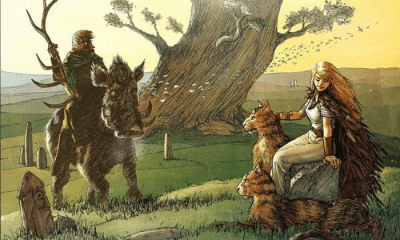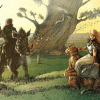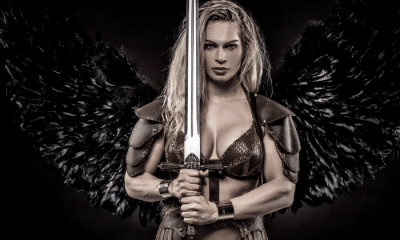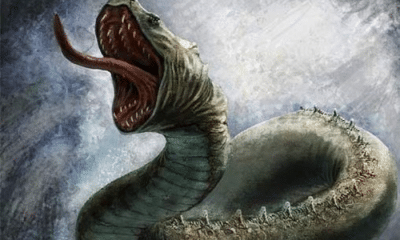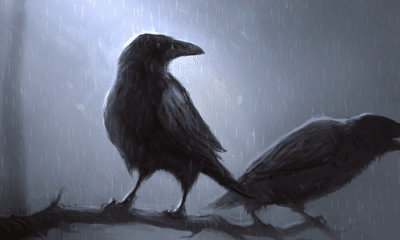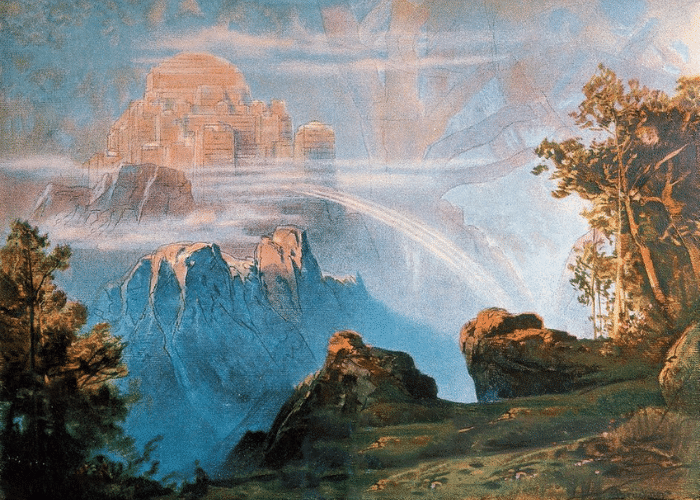
Norse
Valhalla and the Warriors Who Died in Glory
Valhalla and the Warriors Who Died in Glory
Valhalla is one of the most famous places in Norse mythology, but how much do you really know about Odin’s hall and the dead warriors who feasted there?
Many Norse myths and legends reference Valhalla, the greatest hall in Asgard. This massive hall contained the homes of several gods, but was most famous for housing Odin’s legions of dead warriors.
The Einherjar, Odin’s warriors, were chosen from those who fell in battle by the Valkyries. A place in Valhalla was a great honor and a far more desirable fate than the dreary realm of Hel provided.
In Valhalla, these warriors fought and feasted in the company of the gods. Their days were spent enjoying the things that had brought them the most joy in life.
Valhalla was more than just a place of honor, however. The Einherjar were also Odin’s army and, as such, would join him in his final battle.
Who Went to Valhalla?
Many religions claim that a person’s fate in the afterlife is determined by what type of life they lived. In Norse mythology, however, the afterlife is determined by the manner in which they died.
There were many halls belonging to various gods that a person could end up spending their afterlife in. Most went to Hel, the joyless home of the goddess by the same name, while those who drowned at sea were taken by Aegir and Ran.
Some, however, earned a place in the most glorious and desirable version of the afterlife. Those who died in battle joined the warriors known as the Einherjar in Valhalla.
Valhalla was ruled by Odin, the chief of the gods. It was in his realm of Gladsheimr in Asgard.
The Norse believed that the outcome of each battle was determined by Odin. The Valkyries, his female servants watched each fight and claimed the fallen as they died.
While Odin determined the outcome of the battle, he did not take sides in choosing the Einherjar. Men could be chosen from both sides and, while great heroes and kings were the most famous warriors who went there, men of any class or country could be rewarded with an afterlife in Odin’s hall.
Freyja’s Hall
Warriors who died courageously and valiantly were chosen by the Valkyries, a group of female deities who served Odin. The chief of the gods, however, was not the only god they obeyed.
According to some sources, only half of the men who died in each battle joined Odin at his hall. The rest went to Freyja.
Freyja had her own hall, Folkvangr, which received as many men as Valhalla did. In some poems, the Valkyries even gave Freyja the first choice of the dead and sent the remainder to Valhalla.
The association of the goddess of beauty with the fate of great warriors may seem unusual, but Freyja had strong connections to both war and fate.
Some historians believe that Freyja was, in fact, the leader of the Valkyries. One of her duties was to fly over the field of battle herself and single out the most impressive and valiant fighters.
Folkvangr, however, received much less attention in ancient sources than Valhalla did. Even when it was said that Freyja chose her warriors first, Folkvangr was never described in detail.
Many accounts omit Folkvangr altogether. Like many other aspects of Norse belief, it is difficult to know whether this was because it was seen as unimportant, belief waned over time, or if the poems and legends that described it simply did not survive into the modern era.
Some historians believe that none of these interpretations are correct. Leading experts in Norse culture sometimes say that Folkvangr may have been an alternative name for Valhalla.
In this interpretation, Freyja led the Valkyries and chose the first men to go to Valhalla, perhaps singling them out for special honors there. Folkvangr, or the “Field of the Host,” may have referred to the land surrounding Valhalla where the honored dead staged their daily battles.
The Feasts of Valhalla
Of all the realms of the Norse afterlife, Valhalla received the most attention. Many poets described the daily events of Odin’s hall and the activities of the fallen who earned a place there.
Hel was usually depicted as a cold and dreary place, but Valhalla was lively. There, the dead spent each day in the activities they had loved best in life: fighting and feasting.
All the Einherjar
in Odin’s home fields
fight among themselves each day.
The slain they select
then ride from the battlefield;
reconciled, they sit again together
– Poetic Edda, Grímnismál (trans Hollander)
Each day, the Einherjar rode out to the fields that surrounded Valhalla and staged a battle amongst themselves. They relished the adrenaline and bloodlust of battle and had continued opportunities to prove their strength and skill.
Those who fell in these battles, of course, would not be killed again. They would be revived either after the fight or the next morning to continue the cycle again.
By sunset, the warriors would return to the hall to partake in a great feast. Each day they celebrated in a manner that put the halls of even the greatest kings on Midgard to shame.
Valhalla was an enormous hall, capable of seating thousands of men in comfort. Its form was in keeping with its martial nature, with shields and spear shafts making its roof, armor over the seats, and light reflecting off thousands of swords.
Like the halls of living rulers, Valhalla had many rooms for the Einherjar to sleep, eat, and engage in other activities. One source said there were five hundred and forty rooms within the massive hall.
According to some accounts Thor’s home, Bilskirnir, was within Valhalla. Other gods may have made their homes there, too, since in one poem Odin says that Bilskirnir is the greatest of all the many halls within Valhalla.
In the main hall, the Einherjar spent their nights drinking, eating, playing games, and dueling. They were served by the Valkyries, who brought the warriors their food and drinks when they were not needed on the battlefield.
The mead in Valhalla came from enormous vats that were refilled each morning. No matter how many men made their way to Odin’s hall, there was enough mead for each to drink his fill without the vats ever running low.
This mead was not brewed by servants but magically flowed from the udders of a goat called Heidrun. The goat at the leaves of Laeradr, a brightly-colored tree that grew outside Valhalla’s main doors.
Heidrun lived on Valhalla’s roof alongside a hart called Eikthernir. Water flowed from the deer’s antlers to feed all the rivers of the world.
The Einherjar were well supplied with mead and water, but they also ever ran low on food. Odin fed them all from a beast known as Saehrimnir. This beast, sometimes described as a boar, was cooked every day but was made whole again each night to provide food again.
The only being in Valhalla who did not eat the great food there was Odin. He drank only wine and fed his portion of the meal to his wolves, Geri and Freki, just as a human king might feed his hunting dogs from his own plate.
The daily fighting and feasting of Valhalla meant that every warrior there could enjoy the same pleasures they had in life on a grand scale. The daily battles served as more than entertainment, however. They were also training for their final battle.
The Einherjar
While Valhalla was never too full to keep each of its occupants well-fed and comfortable, sources agreed that there was a massive number of men there.
Because any man who died honorably in battle could be taken to Valhalla, there was no way to name all those who feasted there. Some sources, however, said that certain men were welcomed into Odin’s company. Notable among these were:
- Helgi Hundingsbane – Helgi avenged his father by killing the Saxon king, Hunding. He married a valkyrie called Sigrun before being killed by Hunding’s son, Dag, with Odin’s spear. According to some sources, Helgi and Sigrun were reunited in Valhalla and reincarnated at least once.
- Hunding – Helgi’s enemy also earned a place in Valhalla. When Helgi was sent there, he punished the former Saxon king by making him do demeaning manual labor.
- King Vanlandi – The mythical king of Uppsala was killed by a hag rather than in battle, but according to a 10th century poem was still taken to Valhalla.
- Haakon the Good – The 10th century king of Norway attempted to introduce Christianity to his country. He was not entirely successful, however, since a poem written after his death claimed that he had a pagan burial and was taken to Valhalla.
- Eric Bloodaxe – Another 10th century ruler, he is believed to have held power in parts of both Norway and Northumbria. A 13th century poem stated that he was welcomed to Valhalla with special praise because he had fought in more countries than any other king.
- Sigmund – One of the most famous heroes of Germanic lore, he was killed in battle by Odin himself, in disguise as an old man.
- Sinfjotli – Sigmund’s son and nephew, he was also the father of Helgi Hundingsbane. He was taken to Valhalla for his feats in life although he died of poisoning rather than in glory.
Notably, many of those who were said in their legends to have gone to Valhalla did not die in battle. The legends made it clear that other types of death could earn a man a place in Odin’s hall, as well.
Sinfjotli, Sigmund’s son and Helgi’s father, drank a poison that had been intended for his father. He was still, however, given a place in Valhalla.
While the legends typically said that the Valkyries chose men from the battlefield, notable kings and heroes could also enter Valhalla based on the many battles they had fought in life.
Thus, while there was no exceptional honor in Eric Bloodaxe’s death in a treasonous ambush, his arrival in Valhalla was lauded because of his earlier battles and conquests.
This complicates the interpretation of the Norse afterlife, in which the soul’s destination was said to depend on the manner of death. It appears as though two traditions existed in Norse and Germanic folklore.
Most people were, in fact, judged by the way in which they died. If a man participated in several battles but survived and died of old age or disease, he would likely not be taken to Valhalla.
Kings, however, were judged differently. They almost invariably ended up in Valhalla even if their death was not in traditional combat.
This may have been justified by extended the definition of a battle to include political and personal conflicts. Sinfjotli’s wife tried to poison his father to avenge the deaths of her brothers, making the event a type of conflict even if it was not fought with weapons.
Men could also be taken to Valhalla if their death as noble but not bloody. Sinfjotli’s death saved the life of his father, which was a noble deed even if it was done inadvertently.
On the whole, though, the expectation was that kings and heroes were exceptional enough to almost automatically win a place in Valhalla, but other men could earn a place through a heroic death.
The Fate of Valhalla’s Warriors
Whether kings or commoners, however, all the warriors of Valhalla shared a common fate.
Valhalla was more than just a reward for a glorious death or an exceptional life. The Einherjar were also Odin’s army and their daily battles served as training for what would be their last war.
When Ragnarok began, the Einherjar would join their chief in the battle. Their last fight would be the most remarkable in history.
According to Snorri Sturluson’s Prose Edda, the Einherjar would march out of Valhalla as a unified army after Heimdall’s horn sounded. Valhalla had five hundred and forty doors through which eight hundred men could pass at a time and Odin’s warriors would flow out of them in droves.
Odin would lead his men to the field where the battle would take place. There, they would be reunited for the only time with their dead kin.
While the Einherjar joined the gods, the dead of Hel would be their adversaries. Hel and Loki would lead those who had not died with honor against the forces of Asgard and Midgard.
According to most sources, the Einherjar would not do battle with their opposites from Hel’s halls, however. They would join Odin to fight a single enemy.
Odin’s great adversary at Ragnarok would be Fenrir, Loki’s ferocious lupine son. The great wolf was just a mighty foe that it would take all the power of Valhalla to fight him.
Despite their great might and overwhelming numbers, however, the Einherjar would still not defeat the wolf. Fenrir would swallow Odin and all the warriors of Asgard would be killed.
This death would be permanent. There was no further afterlife for Odin’s warriors, so they would cease to exist entirely after being killed by Fenrir.
When the world ended, however, a few gods would survive to rebuild Asgard and Midgard and rule as a new pantheon. A single human couple would also survive to return and repopulate the newly remade world.
New halls would be made for the dead, as well. Future generations would find feasts and comfort in Brimir or Sindri, two new halls that would honor the virtuous and noble dead.
The Evolution of the Underworld
Valhalla is famous as a massive hall in Asgard, but historians have suggested that it was not always seen in this way.
The name Valhalla literally translates as “The Hall of the Slain,” and both Norse and modern sources usually liken it to the halls that housed Germanic nobles. The root of this word, höll, could have other meanings, though.
Before the Viking Age, höll could refer to any covered place or dwelling. While it came to be applied to the large building that housed great men and their retinues, it originally referred to other types of places.
An older translation of Valhalla could have therefore been “The Dwelling Place of the Dead,” This name does not bring to mind the feasting army dining in the home of the gods.
In fact, the older root of höll could have been the root for Valhalla’s opposite as well. Hel, both the goddess and the realm she ruled, was another dwelling place of the dead that could have come from this word.
Some historians believe that this points to an earlier concept of the afterlife in which less distinction was made between the honored dead of Valhalla and the common masses of Hel. Before the legends of Ragnarok and the valkyries grew, all the dead could have entered the same hall.
Valhalla as a general covered place instead of a lord’s hall more closely fit the archetype of the Underworld that is familiar in most world religions. It was not covered by a roof of shields and spears, but by the earth itself.
Scholars believe that the later version of Valhalla grew out of a more traditional version of the Underworld.
This is evidenced by a usage of the world that continued in Swedish folklore. The mountains of Sweden were sometimes called the Valhall.
These mountains were considered by some to be the homes of the dead, albeit without the connotation of honor and feasting offered by the Norse Valhalla.
In this case, the name did not come from the root word höll. Instead, the mountains contained the word hallr, or rock.
This suggests that, even with the older meaning of höll, Valhalla may not have originally been named for a hall at all. Instead, the original meaning was the “Rocks of the Dead,” indicating an Underworld, and the similarities between höll and hallr led to the dead feasting in Odin’s hall.
A Place of Honor in Valhalla
Valhalla was one of many afterlife realms named in Norse mythology, although it is undoubtedly the most well-known and well-attested.
Evolving from an earlier, more generic, version of the Underworld, by the Viking Age Valhalla was seen as the massive hall of Odin. It ran much like the familiar halls of contemporary lords and kings, but on an epic scale.
People were chosen for a place in Valhalla not based on virtue or devotion to the gods, but based on their courage and strength in battle. The Valkyries chose the fallen from the battlefield without regard for their status, class, or even which army they fought for.
Many poets said that half of the dead went to Valhalla and half to Folkvangr, Freyja’s fields. Some, however, interpret Folkvangr as a place within or another name for Valhalla.
While the Valkyries were said to have judged the dead of war in a relatively egalitarian way, Norse poets implied that the selection was not the same for everyone. Some kings and heroes of legend were said to have gone to Valhalla regardless of their manner or place of death.
Both kings and commoners, however, enjoyed the same comfort and enjoyments in the afterlife.
Each day, the Einherjar would dress for battle and face one another on Valhalla’s fields. Each night, they would return to the hall for a feast fit for a king with never-ending food and plentiful mead.
The pleasures of Valhalla, however, would not last forever. At Ragnarok, the Einherjar would march out of Valhalla behind Odin to join him in the final battle and fall against Fenrir.
Valhalla and the Einherjar would be destroyed at Ragnarok, but new halls would welcome the dead after the world was rebuilt.


